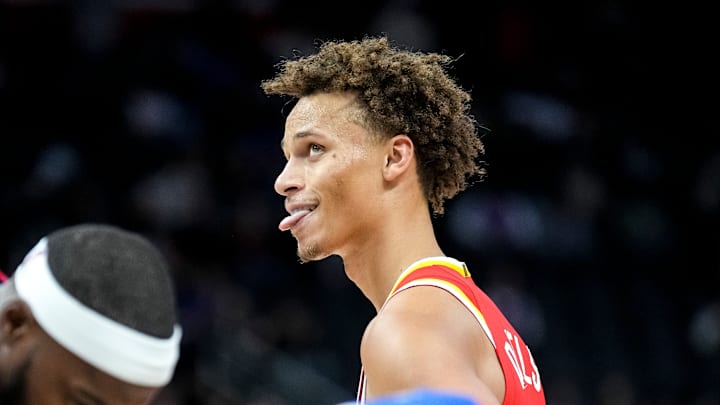In a presser following Monday’s preseason debut for the Atlanta Hawks, Dyson Daniels noted that he will have to push the pace in transition to punish teams that attempt to expose his inconsistent shooting. The Houston Rockets attempted to expose Dyson Daniels’ sole offensive weakness by defending the wing with Alperen Sengun.
While Houston abandoned this approach in minutes, the decision to defend Daniels with a center raised eyebrows among the Hawks community. Sengun is particularly slow-footed on the perimeter, so Daniels was able to expose this through a series of drive-and-kick possessions. Against a big man better equipped to guard a wing like Bam Adebayo or Jarrett Allen, however, Daniels and the Hawks may struggle to create and convert these halfcourt looks.
Daniels’ proposed solution leans into Atlanta’s broader emphasis on transition. While only one preseason game has been played, the Hawks had a transition-heavy run in the early second quarter that propelled them to a dominant run that closed the lead Houston had built. The fast-paced identity fits the team well, as they have the athleticism, energy, and IQ to create easy opportunities in this phase of the game.
Daniels will have to show he has taken a leap as a playmaker for this solution to work, however. He is capable of making the correct read in passing situations, but he has not been a true playmaker who manipulates defenses before dishing the ball.
The league will be on notice if Daniels can negate this strategy
There are two reasons a team may decide it is advantageous to guard Daniels with a center: he is the clear weak link offensively in the starting unit, and Kristaps Porzingis is a shooter who demands close attention. If the center remains on Porzingis, they cannot defend the rim in help defense. Alternatively, centers guarding Daniels are much more comfortable sagging off their man.
For Daniels to deny teams this opportunity, he has to prove he is a dangerous enough threat in a mismatch that he can consistently punish opponents who employ this strategy. The easiest way for Daniels to achieve this is through shooting the three point shot at a higher clip. Of course, shooting is perhaps the most difficult skill in basketball, and it is unlikely Daniels will make a substantial improvement over the course of this season.
If Daniels can become an elite transition threat, however, teams can no longer count on guarding him with a center. Centers are typically slower and occupy deep positions in the paint on offense, which makes them take longer to recover on the fast break. With Daniels leading the break, a perimeter player will be forced to pick him up to prevent an open dunk. This counters the defense’s ability to defend Daniels with a big man.
This change is easier said than done, but the blueprint has been laid out. If Daniels can neutralize this strategy, the Hawks will have no weaknesses for opponents to exploit.
